Life was full of hardship for the early Europeans in the Yukon. Many lived in squalid, cramped conditions. And many were malnourished, with the worst affliction of all being scurvy.
The first men came north with one thing foremost on their minds: finding gold. To that end they sacrificed their youth, their health, and often their lives. The First Nation people who lived in the Yukon had the benefit of centuries of experience learning how to adapt to the extremes of the northern environment. They mastered the art of survival; it’s too bad that the newcomers didn’t learn more lessons from them.
The first prospectors who wintered over in the Yukon basin often lived uncomfortably in squalid tiny huts. Usually shared by several men, some of these unsanitary, primitive, cramped quarters were too low to stand up in. Sometimes windowless, they were illuminated by a small ration of candles, or augmented by animal fat burned in tiny, improvised lamps. One party had to ration their use of candles to a few hours a day during the long periods of darkness to make them last the winter.
Light was sometimes provided by using a block of ice as a window pane. In one early case, such a pane lasted the entire winter, while in another slightly warmer cabin, the ice had to be replaced weekly.
Some stretched canvas or other fabric over an opening to serve as a window. Coated with grease, this material allowed a little light to penetrate the cabin during the short hours of winter daylight. Others improvised by using liquor bottles for window glass.
Chris Sonnickson, who stayed on the upper Yukon the winter of 1886-87, built a tiny hovel with a square hole in the roof to let out the smoke, and a small hearth in the floor to hold a fire. As soon as the fire died down, this smoke-filled cabin was as cold inside as it was as cold as it was outside.
The food left much to be desired. What was available was either brought in by the prospectors, or purchased from a local trader, who had it shipped from Seattle or San Francisco via the Yukon River from St. Michael. If anything disrupted the supply chain, such as impassably low river levels, then supplies became very sparse.
The food was often poor quality. Sometimes the flour got wet during the long journey, leaving it in hard lumps, which they had to pound with a hammer, then sift it before it was usable. Some of the traders grew gardens, but the prospectors moved around too much to do so.
Some hadn’t eaten fresh vegetables in years. One man hadn’t eaten a potato for 10 years.
They relied upon wild game, where they could find it, and fish, when it was available. They even developed a substitute for butter known as “bone butter,” which they manufactured by boiling bone and horn, and adding a little salt to the mixture before the white waxy product congealed.
Ignorance of disease and a lack of medical practitioners led to a wide variety of serious health problems. Diseases like dyspepsia, anemia, rheumatism, pneumonia and bronchitis were common afflictions. Tuberculosis took many of the early miners, who were worn out and susceptible to infection, after years of privation.
Joe Ladue and Arthur Harper, early traders who became well off as a result of the gold rush, learned that wealth was no protection against TB. Both died before enjoying the full benefits of their success.
Of all the diseases, the most insidious and poorly understood was scurvy. Scurvy is caused by a lack of vitamin C, but the early prospectors didn’t know that. They thought it had to do with improperly cooked food, sameness of diet, overwork, lack of exercise or confinement to crowded or poorly ventilated cabins.
Generally, it started after the onset of winter. The victim first developed excruciating pain in his extremities. The parts affected would swell, sometimes turning black, and the skin would lose its elasticity becoming like putty. The gums would become sore and bleed; eventually, the teeth fell out.
This probably didn’t matter because they would soon be dead anyway. The condition of the sufferers was made worse because of the mistaken notion that plenty of exercise would remedy the affliction.
Jack London suffered terribly from the scourge and fled the Yukon as soon as he could after the breakup in the spring of 1898. He quickly recovered from the affliction when he received treatment. Ironically, the disease could readily have been remedied with a little willow, spruce, juniper, rose hips, or Labrador tea, but they didn’t know that.
The saddest account I have read happened to a party camped on the Peel River the winter of 1898-99. A. D. Stewart hurt his leg before Christmas, 1898, and started chronicling physical symptoms in his diary long before he realized it was scurvy. On Jan. 14, he first noted stiff knee joints and tendons.
The pain became excruciating, and three days later, he almost fainted trying to stand up because it hurt so badly. He soon noted red and black discoloration of his skin. His gums began bleeding at the beginning of February and he realized for the first time he had scurvy.
He continued to log his suffering until the last entry in his diary on Feb. 14. R.H. Cresswell, one of his companions, also recorded Stewart’s suffering in his own diary. Day by day, Cresswell noted, Stewart became weaker and weaker, drifting in and out of alertness.
For the last three weeks of his life, Stewart was mercifully spared the pain, and passed away quietly on March 13.
Of all the scourges of the period, scurvy was the worst, and it was so treatable and unnecessary.
Michael Gates is a Yukon historian and sometimes adventurer based in Whitehorse. His new book, Dalton’s Gold Rush Trail, is now available in stores. You can contact him at msgates@northwestel.net
